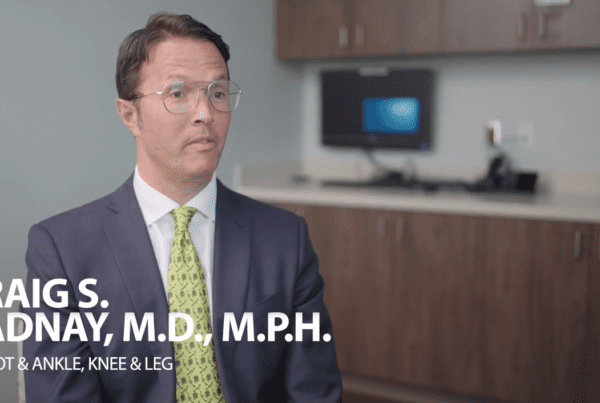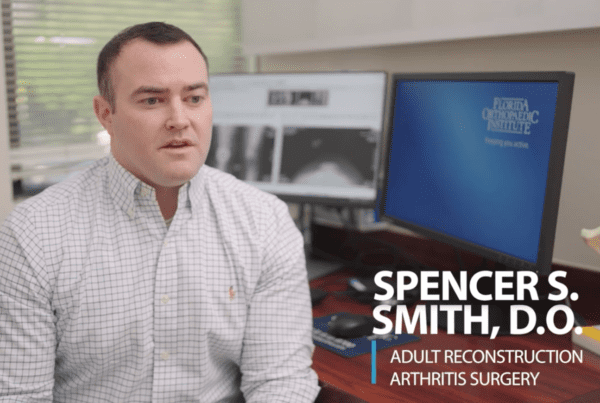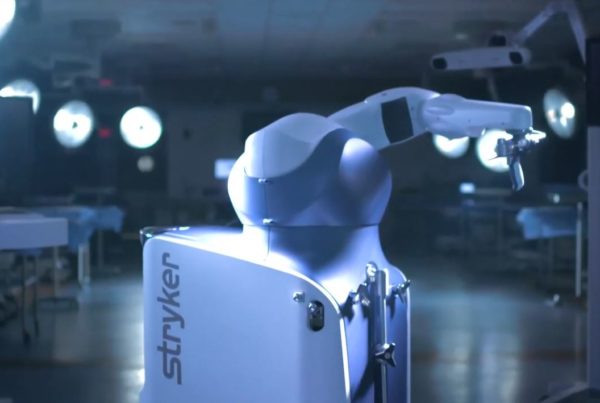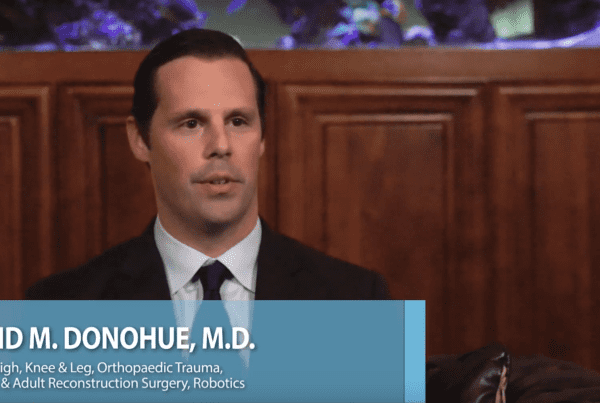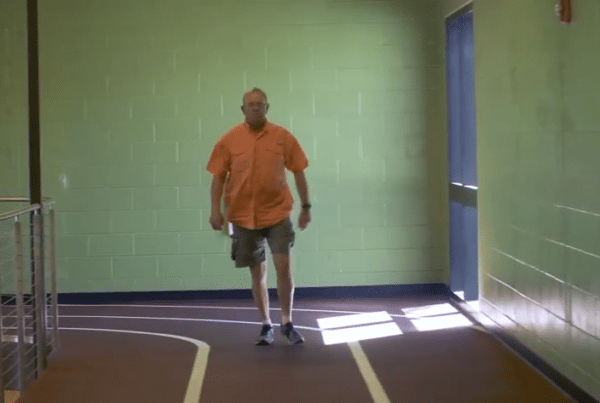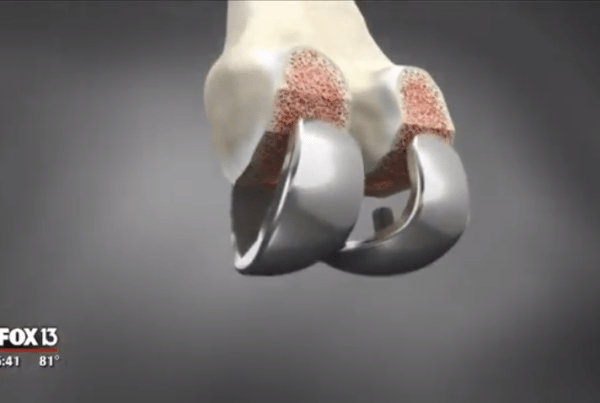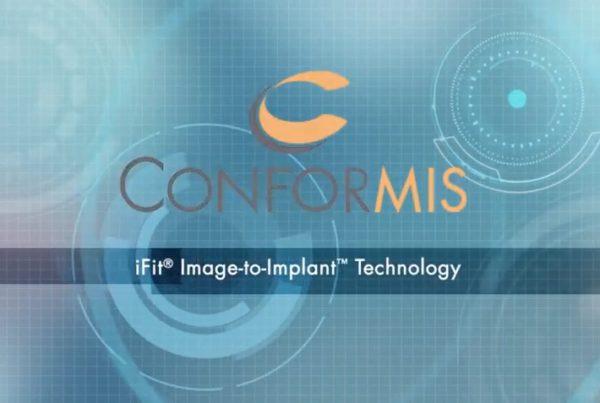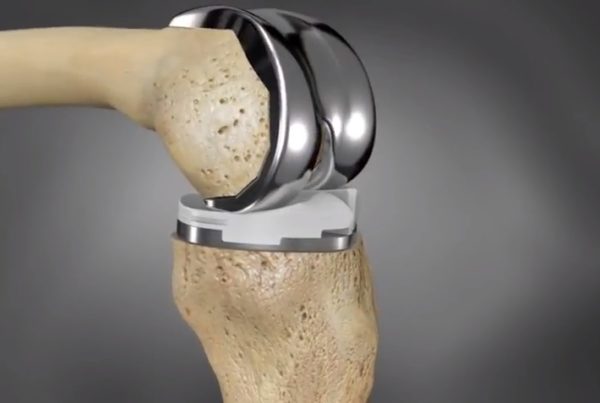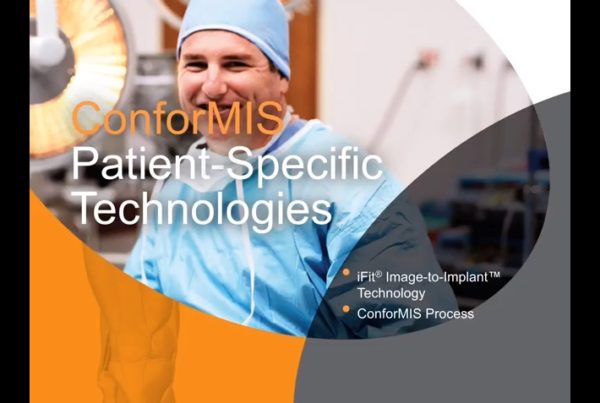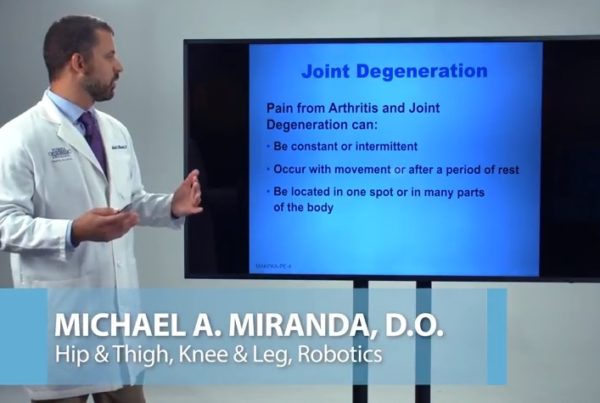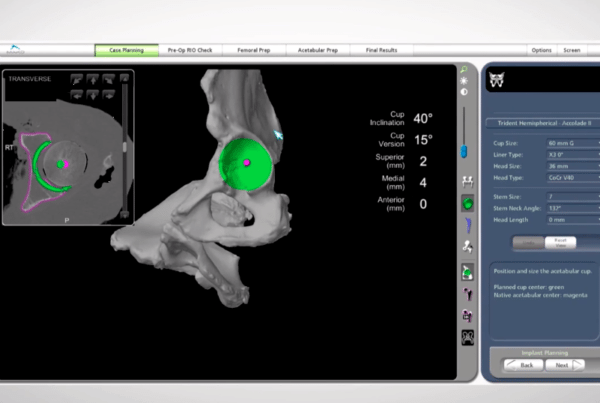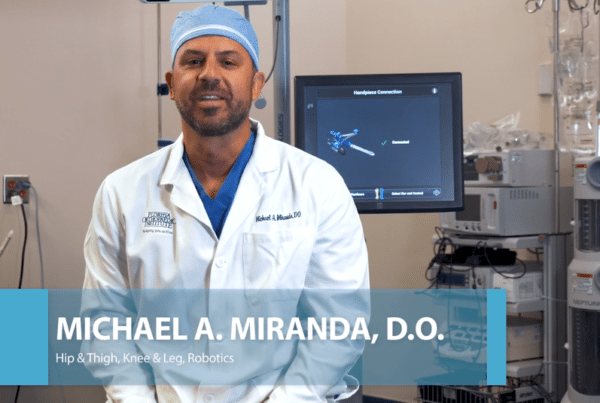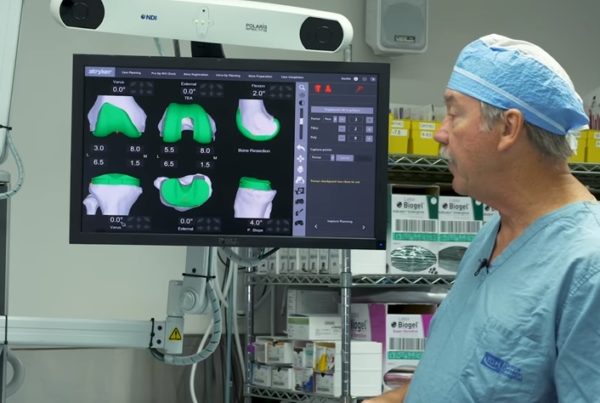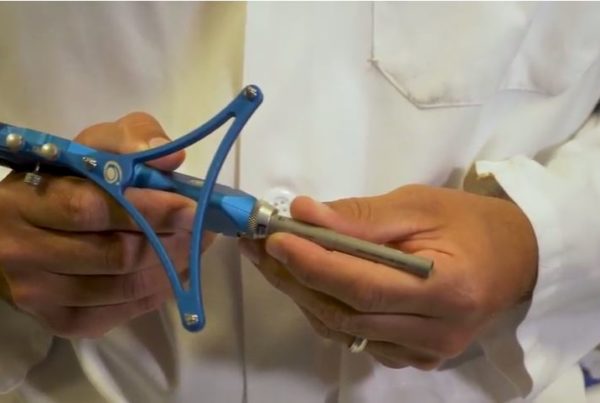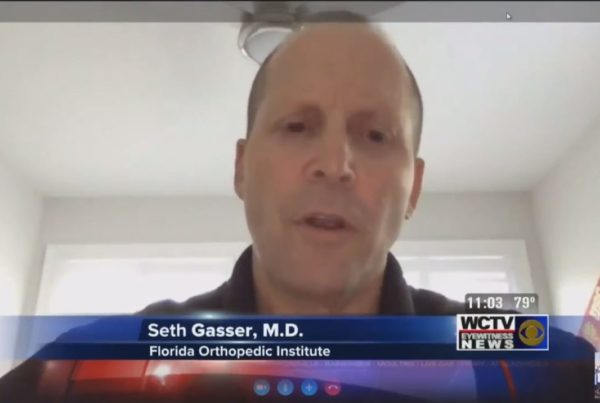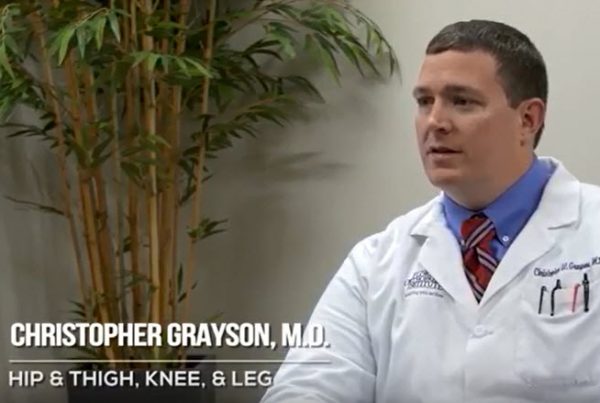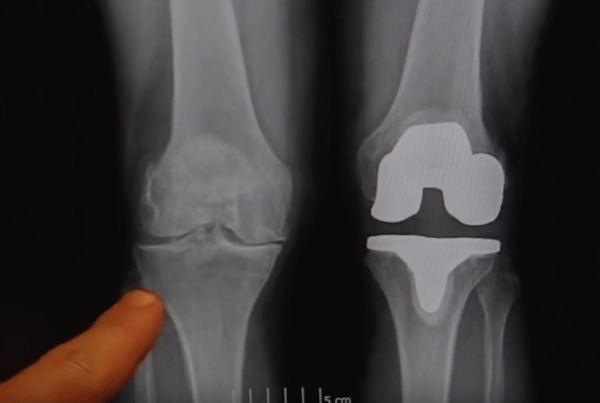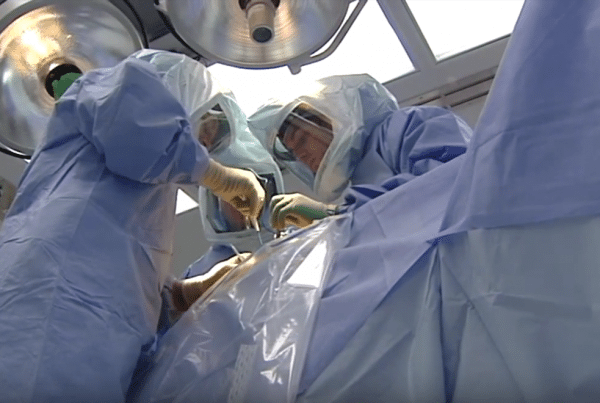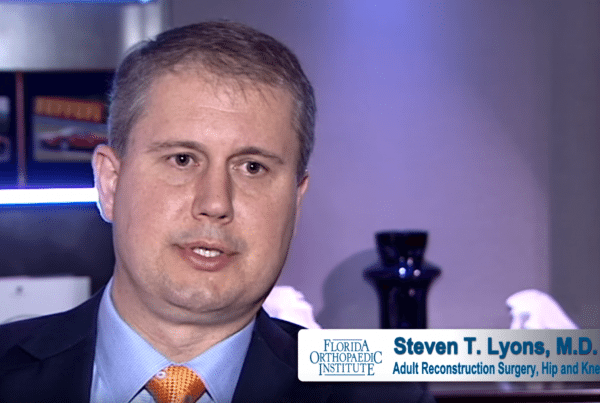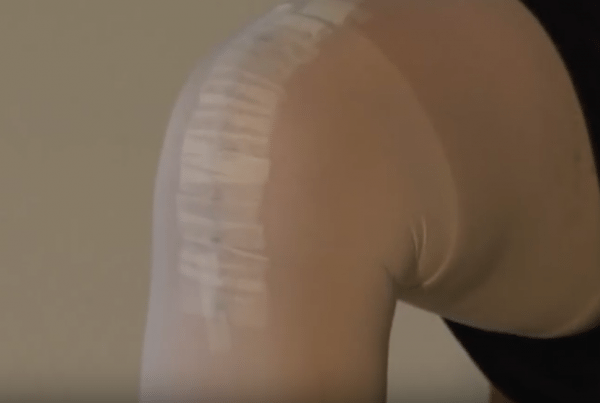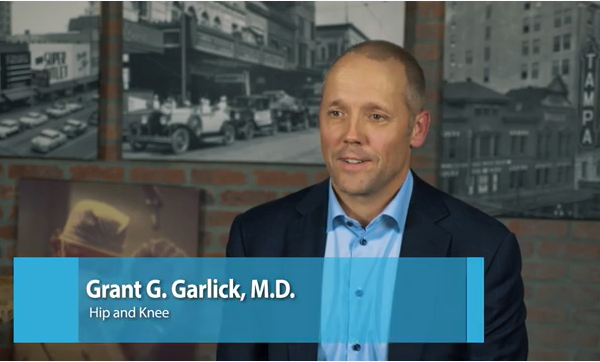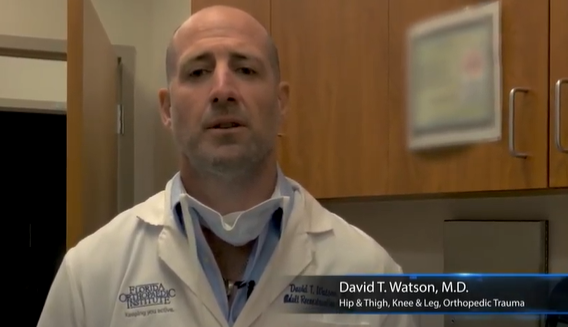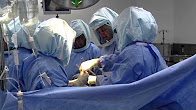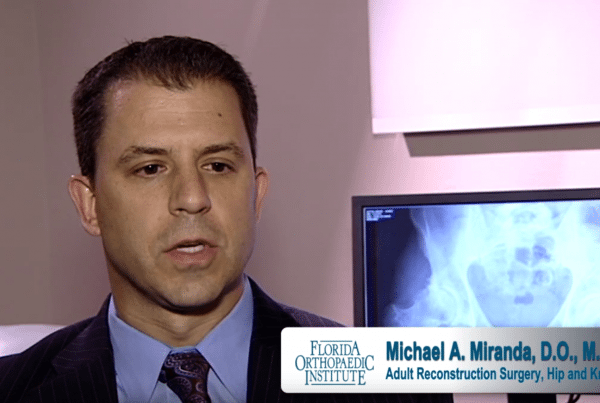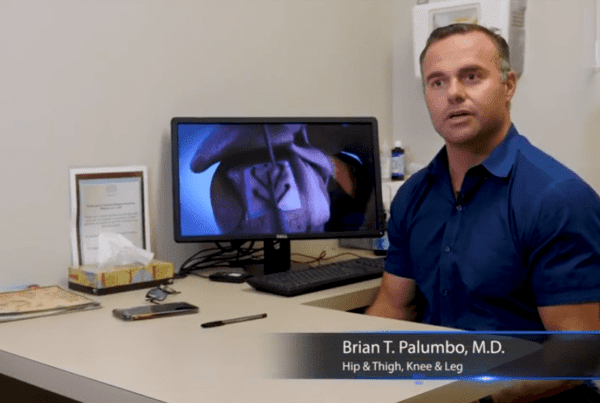Knee & Leg
The Knee
The knee is the body’s largest joint. It’s the place where three bones meet: the tibia, the femur, and the patella. The knee is a “hinge” joint, allowing the leg to bend in only one direction. The knee supplies strength for running, squatting, jumping, and turning. But it doesn’t have the range of motion of other joints, and has almost no ability to rotate.
The knee is a complex system of supportive and moving parts, including bones, cartilage, muscles, tendons, and ligaments – each of which is subject to injury or disease. Because of this, treatment of knee-related injuries and disorders requires a distinct set of skills and experience.
Florida Orthopaedic Institute has expert surgeons who are board certified by the American Board of Orthopaedic Surgery and fellowship trained in adult knee reconstruction. The following represent specific evidence and examples of how our surgeons consistently put into practice progressively advanced practices in the knee area.
The Florida Orthopaedic Institute board certified surgeons provide attentive all-inclusive knee & leg care beginning with a concentrated discussion with each patient about your specific pain or distress. Following this discussion, your surgeon will likely recommend additional assessments including x-rays to assist in determining the source of the cause of your pain. When your comprehensive evaluation is complete, your knee & leg surgeon will explain the diagnosis. They will also discuss all available treatment options. Treating your pain with conservative options is always our priority. However, if non-surgical options won’t accomplish complete success for your needs, our knee & leg surgeons are trained on (and at times assist in the development of) the latest surgical procedures and advancements, including cartilage, restoration, and total knee replacement.
ROSA® Knee Robotic Surgical Assistant
The ROSA® Knee is a robotic surgical assistant for total knee replacement. With ROSA Knee, your surgeon creates a plan for your surgery, based on your unique anatomy. The robot helps to ensure that the plan is executed as intended.
The ROSA Knee does not operate on its own, as the surgeon is in the operating room the entire time making decisions throughout the surgery. ROSA Knee uses a camera and optical trackers to know where your leg is in space. If your leg moves, the robot can tell and adjust accordingly.
ROSA Knee provides the surgeon with data about your knee. This helps to personalize your surgery, based on your knee.
NAVIO® Surgery System
The NAVIO® Surgery System allows Florida Orthopaedic surgeons to perform precise and accurate partial knee replacements. This system, developed by medical device maker Smith & Nephew, involves only a simple x-ray rather than a time-consuming and radiation-intensive CT scan, before the surgeon uses advanced planning software to tailor the surgery to the patient’s anatomy, align the implant, and balance the knee.
As the only location in Florida with the NAVIO robotic assisted surgical system, Florida Orthopaedic surgeons can visualize their patient’s X-rays. By making partial knee replacements a more accessible option through improved precision, patients receive a surgical procedure that is generally associated with smaller incisions, less scarring, and quicker recovery when compared to the total knee replacement alternative. In our Orthopaedic Surgery Center, this procedure is performed as outpatient surgery not requiring a hospital stay.
Using the NAVIO assisted partial knee replacement, patients typically walk and climb stairs the same day of surgery. It helps them return quickly to an active lifestyle.
Florida Orthopaedic Institute is the first and only location in Florida with NAVIO Robotics, and is one of only 79 locations worldwide.
MACI (Matrix Associated Chondrocyte Implantation)
MACI is a technology that uses the patient’s own cartilage cells and glues them into the cartilage defect using a structure known as a cellularized scaffold. MACI is done through smaller incisions with significant improvements in operating time and an easier path to recovery. While this technology is new in the United States, it has an almost 10-year track record in Europe with excellent results.
MACI uses the patient’s own cells to treat cartilage defects in the knee. Many times when a patient comes in to see their doctor with knee pain, the cause is a piece of cartilage that has come loose or worn down. Since cartilage does not grow back, these defects usually get worse over time and can eventually lead the patient to early osteoarthritis. MACI helps many patients avoid early partial and total joint replacements by restoring the cartilage surface of their knee before the problem progresses to a much worse situation.
Learn more about MACIPARTIAL KNEE REPLACEMENT
When the cartilage protecting the bones of the knee slowly wears away, this results in knee osteoarthritis. Osteoarthritis can appear throughout the knee joint or just in a single area of the knee.
If advanced osteoarthritis is limited to a single compartment of the knee, it can be treated with a unicompartmental knee replacement. During a partial knee replacement, damaged bone and cartilage are resurfaced with metal and plastic components. The healthy cartilage, bone, and all of the ligaments are preserved.
For patients whose disease is limited to just one area of the knee, this procedure is an alternative to total knee replacement. Patients usually spend less time in the hospital and return to normal activities sooner than total knee replacement patients because a partial knee replacement is done through a smaller incision.
Learn more about MACIConforMIS® Customized Knee Replacement Implants
ConforMIS knee replacement implants are individually designed and manufactured for each patient, with no two alike. Each implant is sized and shaped to fit each patient’s unique anatomy, offering advantages over other knee implants. It is the first knee replacement that fits only one knee. Yours.
The ConforMIS knee replacement systems offer unique advantages over other implants, including:
- Individualized fit reduces residual pain after surgery
- They follow the shape and contour of each patient’s knee, for a more natural feeling knee
- Designed to preserve the optimal amount of bone
- Pre-navigated instrumentation and surgical planning images verify accuracy throughout the surgery
- Cost is covered by many major insurance companies and similar to standard total knee replacement
Total Knee Replacement (Total Knee Arthroplasty)
When the knee joint is affected by osteoarthritis or rheumatoid arthritis and non-surgical methods have not decreased the pain, total knee replacement surgery (total knee arthroplasty) is a highly successful option. This procedure replaces the infected and painful knee joint with an artificial joint made of state-of-the-art materials.
Learn more about Total Knee ReplacementsMAKO Robotic-Arm Assisted Surgery System
In 2016, Florida Orthopaedic Institute performed an innovative and sophisticated total knee replacement surgery using the MAKO Robotic-Arm Assisted Surgery System. The MAKO system is a surgeon-controlled robotic arm technology that enables accurate alignment and placement of implants. Before the surgery, the MAKO Robotic-Arm Assisted Surgery System creates a 3-D model of your knee to pre-plan the procedure. Your surgeon guides the robotic arm, using the pre-plan guidelines, and removes only the diseased bone. A tremendous advantage of this procedure is that it preserves your healthy bone and soft tissue as well as assisting the surgeon in positioning your implant.
VERILAST® Knee Technology
If you’re considering knee replacement is in your future, VERILAST® Knee Technology from Smith & Nephew is one of the truly significant advancements in joint replacement materials in the past 20 years. It addresses one of the most commonly cited concerns associated with knee replacement implants – implant wear. For the plastic inserts, XLPE ( a special high density polyethylene) reduces the amount of wear against the metal component. The thighbone portion of the VERILAST® implant is made from OXINIUM Oxidized Zirconium – a process that transforms the implant’s surface into a hard, ceramicised metal. It’s more than twice as hard and twice as scratch resistant versus a cobalt chrome implant.
Ask your Florida Orthopaedic Institute surgeon is an implant made with VERILAST technology is right for you.
MENISCUS TEARS
One of the most common knee injuries is a Meniscus tear. The meniscus is a wedge-shaped piece of cartilage that act as a shock absorber between your thighbone and shinbone. Each knee has two.
Meniscus tears occur in athletes, but also those who don’t play sports. The meniscus can also tear through degeneration.
To learn more about the causes, symptoms and treatments for meniscus tears, click below.
Learn more about Meniscus TearsANTERIOR CRUCIATE LIGAMENT (ACL) INJURIES
One of the most common knee injuries are anterior cruciate ligament (ACL) sprains or tears. Sports like soccer, football, and basketball have a higher incidence of ACL injuries.
Anterior cruciate ligaments can be injured when your knee and leg rapidly change direction. Injuries are also caused by deceleration when cutting, pivoting or sidestepping and direct contact or collision. While these causes typically occur in sports, ACL injuries can happen in non-athletes from stopping suddenly, slowing down while running or other twisting movements.
ACL injuries may need surgery to regain full function of the knee, depending on the severity of the injury, activity level, and other factors.
Treatment for ACL tears includes nonsurgical treatments, arthroscopic surgery, as well as surgical repairs.
Florida Orthopaedic Institute knee and leg surgeons stay current on the latest ACL treatments, research and repair options.
Learn more about ACL InjuriesThe Leg
The leg is composed of muscles, bones, blood vessels and tissues and activities associated with walking, jumping, skating, etc. rely on the interactive support of your leg’s construction for you to move. Common leg injuries occur during sports, recreational and personal or professional work-related activates.
If the problem with your leg is not related to a specific injury, your discomfort may be associated with a different cause. For example, mature adults, who tend to lose muscle mass as they age, tend to be at higher risk for certain issues. Overactivity in children or a rapid growth of their bone and muscle may threaten a child’s muscles. The following includes some examples of complications to your leg that may not be related to a particular injury occurrence.
- Overuse injuries, although not actual injuries, are associated with activities that you repeatedly perform on a regular basis. Athletes who “overdo” a muscle or series of muscles may include swimmers, pitchers, basketball players, etc. Overuse injuries are not limited to sports. They can include any individual who repeatedly performs the same activity. An overuse injury may result in tendonitis, stress fractures, bursitis, or additional muscle strain.
- Leg problems that affect your blood vessels – referred to as “vascular disease” – may include a blood clot or complications with your arteries.
- Stiffness, swelling and joint pain may suggest of a type of arthritis.
Many leg problems repair themselves on their own with home treatments that promote healing. Serious leg problems will need the attention of an experienced orthopedic specialist. If in doubt, make an appointment to discuss your symptoms with one of our physicians listed below. The Florida Orthopaedic Institute’s team of board certified surgeons stay current on that latest treatments and innovative research.
SHIN SPLINTS
Whether you’re young or old or anywhere in between, shin splints can happen to anyone who’s participating in physical activity. Only in the rarest of cases will they need surgery as they can be resolved through nonsurgical means.
Shin splints usually happen after unusual or sudden changes in activity – from starting a new workout routine or playing a different sport than you’re used to.
Also known as medial tibial stress syndrome, shin splints are caused by pain along the inner edge of the shinbone (tibia) and occur when the muscles, tendons and bone tissue around the tibia become worn or inflamed due to physical activity or exercise.
To learn more about the symptoms, diagnosis and treatment of shin splints, click below.
Learn more about Shin SplintsMuscle Spasms
A muscle spasm is when a muscle suddenly squeezes on its own. They are also known as a cramp or “charlie horse.” Muscle spasms can cause sharp pain that lasts a few seconds or several minutes. If the spasm is strong enough, it can leave a lump on the muscle. Muscle spasms usually affect the thighs, calves, feet arms and hands.
Learn more about Muscle SpasmsArthroscopic Chondroplasty
Used to repair a small area of damaged cartilage in the knee, arthroscopic chondroplasty is an outpatient procedure. During the procedure, damaged tissue is removed, allowing healthy cartilage to grow in its place. Arthroscopic chondroplasty is performed through small incisions on the sides of the knee with the aid of a small video camera called an arthroscope.
Learn more about Arthroscopic ChondroplastyFractures Of The Tibial Spine
A tibial spine fracture, also known as a tibial eminence fracture, is an intra-articular fracture of the bony attachment of the ACL on the tibia. The fracture occurs on a portion of the tibia (shin bone) in the knee joint. The tibial spine is a specialized ridge of bone in the tibia where the ACL (anterior cruciate ligament) attaches. The ACL is important in maintaining flexibility and stability in the knee.
Tibial spine fractures are most commonly seen in children from age 8 to 14 years during athletic activity.
Tibial spine fractures usually occur as the result of traumatic events such as rapid deceleration or hyperextension/rotation of the knee, as in sports. In adults, the same forces that would cause an ACL (anterior cruciate ligament) to tear can cause a tibial spine fracture. Trauma resulting in hyperextension such as a fall from bike or motorcycle can also cause this type of fracture.
Learn more about Fractures Of The Tibial SpineLateral Collateral Ligament (LCL) Injuries
The lateral collateral ligament (LCL) is one of four major ligaments that helps stabilize the knee joint. It is found on the outer side of your knee and is a short band of tough fibrous connective tissue.
LCL sprains are the most common form of LCL injury, but lateral collateral ligament injuries only account for 2% of all knee ligament injuries. Most LCL injuries occur in combination with damage to other knee ligaments and structures.
The main function of your lateral collateral ligament is to resist sideways force and rotation. LCLs are injured when the force is too great for the ligament to resist and the ligament is overstretched. This can happen through a sharp change in direction, incorrect landing technique, twisting the knee while the foot is fixed, hyperextension of the knee or a blunt force hit to the knee, such as in football tackle or a motor vehicle accident.
Learn more about Lateral Collateral Ligament (LCL) InjuriesILIOTIBIAL BAND SYNDROME (ITBS)
Iliotibial Band Syndrome (ITBS), also called Iliotibial Band Friction Syndrome, is a painful condition in which connective tissue (the Iliotibial Band ligament) rubs against the thighbone.
It is common, with more than 200,000 cases in the U.S. every year. Distance runners are especially susceptible to the condition. Pain between the hip and knees that worsens with activity, especially just above the knee joint, is the main symptom.
Learn more about Iliotibial Band Syndrome (ITBS)MEDIAL COLLATERAL LIGAMENT (MCL) INJURIES
The Medial Collateral Ligament (MCL) is a band of tissue on the inside of the knee, connecting the thighbone to the bone of the lower leg. Your MCL keeps your knee from bending inward. An MCL injury is a tear or sprain to the medial collateral ligament.
The MCL can be injured by bending, twisting, or a quick change of direction. MCL injuries also occur in spots when the outside of the knee is hit. Symptoms include pain, bruising, swelling, and tenderness. It might become harder to move your knee.
Learn more about Medial Collateral Ligament (MCL) InjuriesQUADRICEPS TENDON TEARS
A quadriceps tendon tear is a rare but severe injury. It occurs when the tendon that attaches the quadriceps muscle (a group of 4 muscles in the front part of the leg) to the kneecap (patella) tears. The quadriceps tendon can be partially or completely torn.
Quadriceps tendon tears are not common (less than 2 people per 100,000) and occur most often among middle-aged people (older than 40 years) who play running or jumping sports.
Learn more about Quadriceps Tendon TearsPatellar Fractures
A patellar fracture is a break of the patella – the small bone in the front of your knee, often called the “kneecap.” The patella protects the joint and helps link your thigh muscles to your lower leg.
Patella fractures account for 1% of all skeletal injuries and are twice as likely to occur in males versus females. Most patella fractures occur in the 20-50 year age range.
Symptoms include bruising, swelling, and pain to the front of the knee. A person with a patella fracture may be unable to walk or straighten their leg.
Learn More About Patellar FracturesARTICULAR CARTILAGE RESTORATION
The smooth, white tissue that covers the ends of bones where they come together to form joints is your articular cartilage. Healthy cartilage allows the bones to glide over each other with very little friction and makes it easier to move.
Injury or normal wear and tear can damage articular cartilage. Surgical techniques have been developed to stimulate the growth of new cartilage because cartilage does not heal itself well. When articular cartilage is restored, it allows better function, relieves pain, and delays or prevents arthritis onset.
There are many surgical techniques to repair damaged cartilage – some of which are still evolving.
Learn more about ARTICULAR CARTILAGE RESTORATIONRUNNER’S KNEE
Also called Patellofemoral Pain Syndrome, or PFPS, this is a pain you feel in the front of your knee. It involves the patella, the bone we commonly call the kneecap. The patella slides up and down in a groove on your femur as you bend and extend your knee.
Patellofemoral Pain Syndrome is called runner’s knee or jumper’s knee because it is common in people who participate in sports, particularly females and young adults. Runner’s knee is a broad term used to describe pain in the front of the knee and around the patella.
If you have this syndrome, the pain and stiffness can make it difficult to climb stairs, kneel, and perform other everyday activities. You may have injured the soft tissues that support and cushion your kneecap. Or you may have some damage to the cartilage on the underside of the kneecap.
LEARN MORE ABOUT RUNNER’S KNEEDEEP THIGH BRUISING
Deep thigh bruising is a common injury that occurs when the muscles in the thigh are subjected to a sudden impact or force. This can cause the blood vessels within the muscle tissue to rupture, leading to bleeding and bruising. Deep thigh bruises are often more severe than surface bruises, resulting in significant pain, swelling, and limited mobility.
Symptoms of deep thigh bruising can include pain, tenderness, swelling, bruising, limited range of motion, numbness, and stiffness or weakness in the leg.
LEARN MORE ABOUT DEEP THIGH BRUISINGMuscle Strains of The Calf (Gastrocnemius & Soleus Strains)
Muscle strains of the calf are a common injury that affects the gastrocnemius and soleus muscles, which are located at the back of the lower leg. A muscle strain occurs when the muscle fibers are stretched or torn beyond their limits. This can happen due to sudden movements or overuse of the muscle. In the case of calf strains, common causes include running, jumping, and sudden changes in direction.
Symptoms of a calf strain may include pain, swelling, and stiffness in the affected area. Depending on the severity of the strain, there may also be bruising or difficulty walking.
LEARN MORE ABOUT MUSCLE STRAINS OF THE CALFAreas of focus: Knee & Leg
- Knee & Leg
- ACL Injuries
- Arthroscopic Chondroplasty
- Articular Cartilage Restoration
- Deep Thigh Bruising
- Fractures Of The Tibial Spine
- Iliotibial Band Syndrome
- Lateral Collateral Ligament (LCL) Injuries
- MACI
- Medial Collateral Ligament Injuries
- Meniscus Tears
- Muscle Spasms
- Muscle Strains of The Calf
- Partial Knee Replacement
- Patellar Fracture
- Quadriceps Tendon Tear
- Runner's Knee
- Senior Strong
- Shin Splints
- Total Knee Replacement Surgery
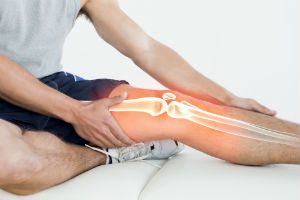
Knee Replacement Success
See how Dr. Bernasek helped one patient stay active after a knee replacement.
Common Knee & Leg Conditions
- Anterior Cruciate Ligament (ACL) Injuries
- Anterior Cruciate Ligament (ACL) Tear
- Avascular Necrosis (Osteonecrosis) of the Knee
- Deep Vein Thrombosis (DVT)
- Fractures of the Tibial Spine
- Goosefoot (Pes Anserine) Bursitis of the Knee
- Meniscus Tears
- Osgood-Schlatter Disease
- Osteoarthritis of the Knee
- Osteochondritis Dissecans of the Knee
- Patellar Fracture (Broken Knee Cap)
- Patellar Tendon Rupture
- Patellar Tracking Disorder
- Patellofemoral Pain Syndrome (Runner’s Knee)
- Prepatellar Bursitis (Kneecap Bursitis)
- Quadriceps Tendon Tear
- Septic Arthritis of the Knee
- Shin Splints (Medial Tibial Stress Syndrome)
- Supracondylar Femoral Fracture
- Tibial Fractures
- Tibial Plateau Fracture
- Torn Posterior Cruciate Ligament (PCL)
Common Knee & Leg Procedures
- ACL Reconstruction
- ACL Reconstruction with Hamstring
- ACL Reconstruction with Hamstring using Arthrotek® and EZLOC™ Devices
- Arthroscopic Chondroplasty
- Arthrosurface® Hemicap® Resurfacing
- Autologous Chrondrocyte Transplantation
- Cartilage Repair
- Fluoroscopic Guided Steroid Injection for Knee Pain
- High Tibial Osteotomy
- Joint Arthroscopy
- Knee Resurfacing
- Lateral Release and Medial Imbrication
- Loose Body Removal (Knee)
- Meniscal Transplant
- Meniscus
- Microfracture Drilling Procedure for Isolated Chondral Defect
- Mini-Incision Total Knee Replacement
- Oats Cartilage Repair Surgery
- Orthoglide® Medial Knee Implant
- Partial Knee Replacement (using Oxford® Implant)
- Partial Meniscectomy
- Patellogemoral Replacement
- Posterior Cruciate Ligament (PCL) Reconstruction
- Revision Knee Surgery
- Revision Knee with Tibial Tubercle Osteotomy
- Tibial Osteotomy with Closed Wedge
- Tibial Osteotomy with Open Wedge
- Total Knee Replacement
- Visco-Supplementation for Arthritis of the Knee
Specialties
- AC Joint Injuries
- Achilles Tendinitis - Achilles Insertional Calcific Tendinopathy (ACIT)
- Achilles Tendon Rupture
- Achilles Tendonitis
- ACL Injuries
- Ankle Fracture Surgery
- Ankle Fractures (Broken Ankle)
- Ankle Fusion Surgery
- Anterior Cervical Corpectomy & Discectomy
- Arthroscopic Articular Cartilage Repair
- Arthroscopic Chondroplasty
- Arthroscopic Debridement of the Elbow
- Arthroscopy Of the Ankle
- Articular Cartilage Restoration
- Artificial Disk Replacement (ADR)
- Aspiration of the Olecranon Bursa - Fluid In Elbow
- Atraumatic Shoulder Instability
- Avascular Necrosis (Osteonecrosis)
- Bankart Repair
- Basal Joint Surgery
- Bicep Tendon Tear
- Bicep Tenodesis
- Bone Cement Injection
- Bone Growth Stimulation
- Bone Health Clinic
- Broken Collarbone
- Bunions
- Bursitis of the Shoulder (Subacromial Bursitis)
- Calcific Tendinitis of the Shoulder
- Carpal Tunnel Syndrome
- Charcot Joint
- Chiropractic
- Clavicle Fractures
- Colles’ Fractures (Broken Wrist)
- Common Foot Fractures in Athletes
- Community Outreach
- Cubital Tunnel Syndrome
- De Quervain's Tenosynovitis
- Deep Thigh Bruising
- Degenerative Disk Disease
- Diffuse Idiopathic Skeletal Hyperostosis (DISH)
- Discectomy
- Discitis Treatment & Information
- Dislocated Shoulder
- Dupuytren’s Disease
- Elbow
- Elbow Bursitis
- Elbow Injuries & Inner Elbow Pain in Throwing Athletes
- Epidural Injections for Spinal Pain
- Finger Dislocation
- Flexor Tendonitis
- Foot Stress Fractures
- Foot, Ankle & Lower Leg
- Foraminotomy
- Fractured Fingers
- Fractures Of The Shoulder Blade (Scapula)
- Fractures Of The Tibial Spine
- Functional Nerve Transfers of The Hand
- Ganglion Cysts
- General Orthopedics
- Glenoid Labrum Tear
- Golfer's Elbow
- Groin Strains and Pulls
- Growth Plate Injuries Of The Elbow
- Hallux Rigidus Surgery - Cheilectomy
- Hammer Toe
- Hamstring Injuries
- Hand & Finger Replantation
- Hand & Wrist
- Hand Nerve Decompression
- Hand Skin Grafts
- Hand, Wrist, Elbow & Shoulder
- Heat Injury/Heat Prostration
- High Ankle Sprain (Syndesmosis Ligament Injury)
- Hip & Thigh
- Hip Arthroscopy
- Hip Dislocation
- Hip Flexor Strains
- Hip Fractures
- Hip Hemiarthroplasty
- Hip Impingement Labral Tears
- Hip Muscle Strains
- Hip Pointers and Trochanteric Bursitis
- Hyperextension Injury of the Elbow
- Iliopsoas Tenotomy
- Iliotibial Band Syndrome
- Impingement Syndrome of the Shoulder
- Interlaminar Implants
- Interlaminar Lumbar Instrumental Fusion: ILIF
- Interventional Pain Management
- Interventional Spine
- Intraarticular Calcaneal Fracture
- Joint Replacement
- Knee & Leg
- Kyphoplasty (Balloon Vertebroplasty)
- Kyphosis
- Labral Tears Of The Hip (Acetabular Labrum Tears)
- Laminectomy: Decompression Surgery
- Lateral Collateral Ligament (LCL) Injuries
- Lisfranc Injuries
- Little League Shoulder
- LITTLE LEAGUER'S ELBOW (MEDIAL APOPHYSITIS)
- Lumbar Epidural Steroid Injection
- Lumbar Interbody Fusion (IBF)
- MACI
- Mallet, Hammer & Claw Toes
- Medial Collateral Ligament Injuries
- Meniscus Tears
- Metatarsalgia
- Minimally Invasive Spine Surgery
- Morton’s Neuroma
- Muscle Spasms
- Muscle Strains of The Calf
- Nerve Pain
- Neuromas (Foot)
- Neurosurgery
- Olecranon Stress Fractures
- Orthopaedic Total Wellness
- Orthopaedic Trauma
- Orthopedic Physician Or A Podiatrist? Definition of a Podiatrist
- Osteoarthritis of the Hip
- Osteoporosis
- Outpatient Spine Surgery
- Partial Knee Replacement
- Patellar Fracture
- Pelvic Ring Fractures
- Peripheral Nerve Surgery (Hand) Revision
- Pinched Nerve
- Piriformis Syndrome
- Piriformis Syndrome
- Plantar Fasciitis
- Plastic Surgery
- Podiatry
- Primary Care Sports Medicine
- Quadriceps Tendon Tear
- Radial Tunnel Syndrome (Entrapment of the Radial Nerve)
- Revascularization of the Hand
- Reverse Total Shoulder Replacement
- Rheumatoid Arthritis (RA) of the Shoulder
- Rheumatoid Arthritis Of The Hand
- Robotics
- Rotator Cuff Tears
- Runner's Knee
- Sacroiliac Joint Pain
- Sciatica
- Scoliosis
- Senior Strong
- Shin Splints
- Shoulder
- Shoulder Arthritis
- Shoulder Arthroscopy
- Shoulder Injury: Pain In The Overhead Athlete
- Shoulder Replacement
- Shoulder Separations
- Shoulder Socket Fracture (Glenoid Fracture)
- SLAP Tears & Repairs
- Spinal Fusion
- Spine
- Spondylolisthesis and Spondylolysis
- Sports Foot Injuries
- Sports Hernias (Athletic Pubalgia)
- Sports Medicine
- Sports Wrist and Hand Injuries
- Sprained Ankle
- Sprained Wrist Symptoms and Treatment
- Subacromial Decompression
- Sudden (Acute) Finger, Hand & Wrist Injuries
- Targeted Muscle Reinnervation (TMR)
- Tendon Transfers of The Hand
- Tennis Elbow Treatment
- Thigh Fractures
- Thigh Muscle Strains
- Thumb Ulnar Collateral Ligament Injuries
- Total Ankle Replacement
- Total Hip Arthroplasty
- Total Hip Replacement - Anterior Approach
- Total Knee Replacement Surgery
- Trapezius Strain (Muscle Strain of The Upper Back)
- Traumatic Shoulder Instability
- Tricep Pain & Tendonitis
- Trigger Finger
- Turf Toe
- UCL (Ulnar Collateral Ligament) Injuries
- Ulnar Neuritis
- Valgus Extension Overload
- Vertebroplasty
- WALANT (Wide Awake Local Anesthesia No Tourniquet)
- Whiplash and Whiplash Associated Disorder (WAD)
- Wound Care
- Wrist Arthroscopy
- Wrist Fractures
- Wrist Tendonitis
Services
- Physical Medicine & Rehabilitation
- Physical Therapy
- Primary Care Sports Medicine
- PROMs (Patient-Reported Outcome Measures)
- Same-Day Orthopaedic Appointments Now Available
- Sports Medicine
- Sports-Related Concussion Treatment
- Telehealth Page
- Telemedicine
- Workers' Compensation
- Workers' Compensation Dispensary
- X-Ray




